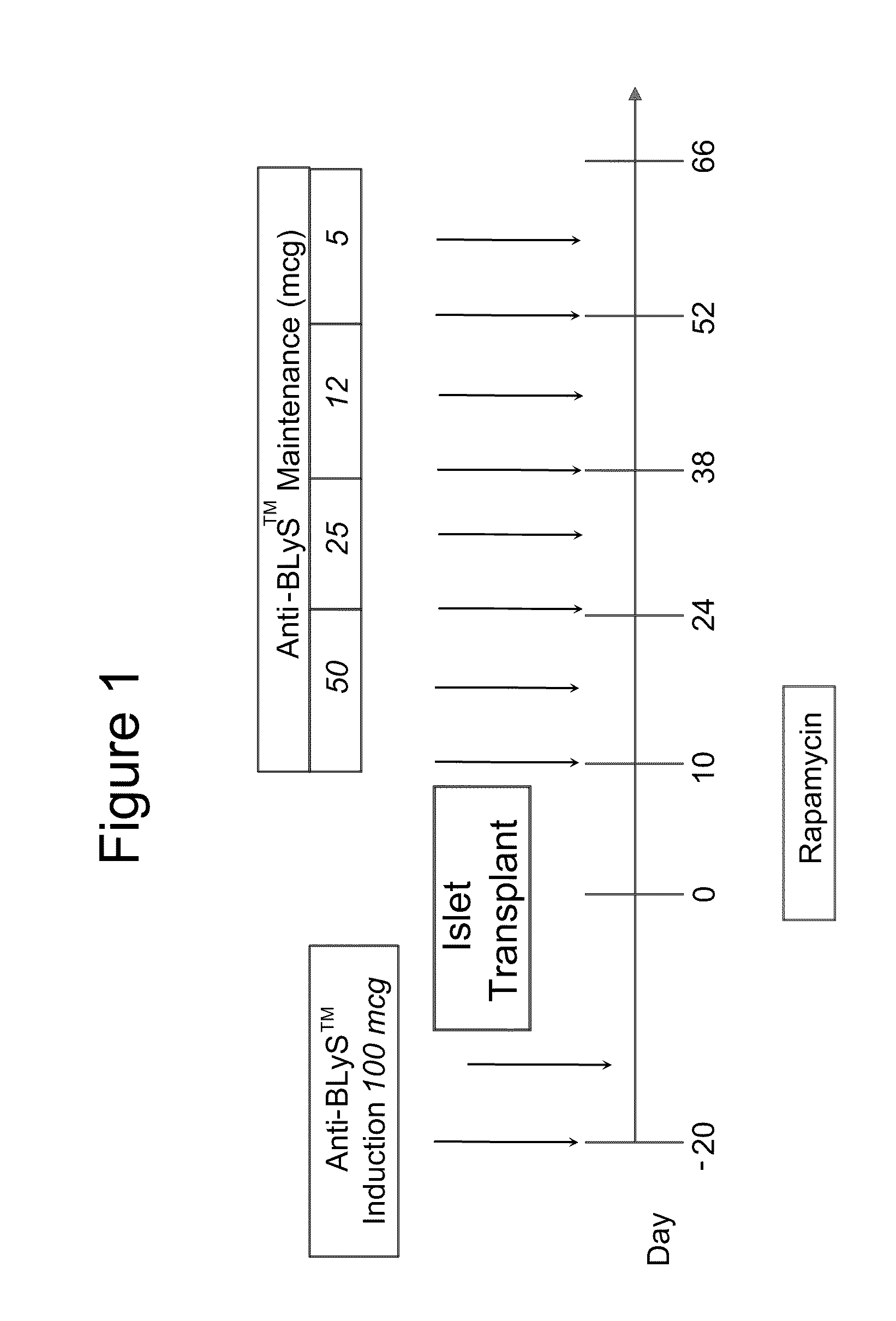Use of b lymphocyte stimulator protein antagonists to promote transplantation tolerance
a technology of b lymphocytes and stimulators, which is applied in the direction of immunosuppressive therapy, antibody medical ingredients, peptide/protein ingredients, etc., can solve the problems of unsatisfactory long-term allograft survival rates, the risk of losing the new organ due to rejection, and the lifetime of immunosuppressive therapy, so as to reduce the antibody titer in the patient, inhibit or reduce the production of immunoglobulin, and reduce the effect of antibody ti
- Summary
- Abstract
- Description
- Claims
- Application Information
AI Technical Summary
Benefits of technology
Problems solved by technology
Method used
Image
Examples
example 1
[0253]This example demonstrates the isolation of antibody fragments directed against B Lymphocyte Stimulator protein from a library of scFvs.
[0254]Naturally occurring V-genes isolated from human PBLs are constructed into a large library of antibody fragments which contain reactivities against B Lymphocyte Stimulator protein to which the donor may or may not have been exposed (see e.g., U.S. Pat. No. 5,885,793 incorporated herein in its entirety by reference).
[0255]Rescue of the Library.
[0256]A library of scFvs is constructed from the RNA of human PBLs as described in WO92 / 01047 (which is hereby incorporated by reference in its entirety). To rescue phage displaying antibody fragments, approximately 109 E. coli harboring the phagemid are used to inoculate 50 ml of 2×TY containing 1% glucose and 100 micrograms / ml of ampicillin (2×TY-AMP-GLU) and grown to an O.D. of 0.8 with shaking. Five ml of this culture is used to inoculate 50 ml of 2×TY-AMP-GLU, 2×108 TU of delta gene 3 helper (M13...
example 2
[0262]This example demonstrates the neutralization of B Lymphocyte Stimulator protein receptor interaction with an anti-B Lymphocyte Stimulator protein monoclonal antibody.
[0263]Monoclonal antibodies were generated against B Lymphocyte Stimulator protein according to the following method. Briefly, mice were given a subcutaneous injection (front part of the dorsum) of 50 micrograms of His-tagged B Lymphocyte Stimulator protein in 100 microliters of PBS emulsified in 100 microliters of complete Freunds adjuvant. Three additional subcutaneous injections of 25 micrograms of B Lymphocyte Stimulator protein in incomplete Freunds adjuvant were given at 2-week intervals. The animals were rested for a month before they received the final intraperitoneal boost of 25 micrograms of B Lymphocyte Stimulator protein in PBS. Four days later mice were sacrificed and splenocytes taken for fusion.
[0264]The process of “Fusion” was accomplished by fusing splenocytes from one spleen were with 2×10E7 P3X6...
example 3
[0278]This example demonstrates competitive binding studies between antibody 15C10 and 3D4.
[0279]To determine if antibodies 15C10 and 3D4 bind similar or distinct epitopes, competitive binding studies were performed.
[0280]Soluble B Lymphocyte Stimulator protein was preincubated with 15C10 or 3D4 antibodies. Hereinafter in this example, the antibody with which B Lymphocyte Stimulator protein was preincubated will be referred to as the “competing antibody”. After preincubation, soluble B Lymphocyte Stimulator protein-competing antibody complexes were captured on an ELISA plate coated with either 3D4 or 15C10. Hereinafter in this example, the antibody coated on the ELISA plate will be referred to as the “capture antibody.” After binding, and wash steps, soluble B Lymphocyte Stimulator protein-competing antibody complexes captured on the 3D4 or 15C10-coated ELISA plates was detected using a biotinylated polyclonal anti-B Lymphocyte Stimulator protein antibody followed by a streptavidin-...
PUM
| Property | Measurement | Unit |
|---|---|---|
| Fraction | aaaaa | aaaaa |
| Fraction | aaaaa | aaaaa |
| Fraction | aaaaa | aaaaa |
Abstract
Description
Claims
Application Information
 Login to View More
Login to View More - Generate Ideas
- Intellectual Property
- Life Sciences
- Materials
- Tech Scout
- Unparalleled Data Quality
- Higher Quality Content
- 60% Fewer Hallucinations
Browse by: Latest US Patents, China's latest patents, Technical Efficacy Thesaurus, Application Domain, Technology Topic, Popular Technical Reports.
© 2025 PatSnap. All rights reserved.Legal|Privacy policy|Modern Slavery Act Transparency Statement|Sitemap|About US| Contact US: help@patsnap.com



